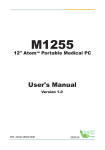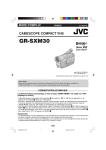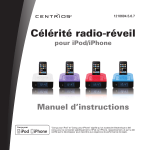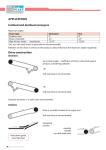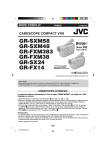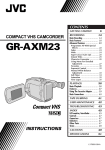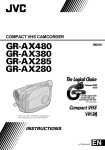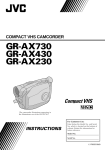Download JVC AA V15U User's Manual
Transcript
ENGLISH AC POWER ADAPTER/CHARGER ADAPTATEUR SECTEUR/CHARGEUR DE BATTERIE FRANÇAIS AA-V15U INSTRUCTIONS MANUEL D’INSTRUCTIONS For Customer Use: Enter below the Serial No. which is located on the bottom of the unit. Retain this information for future reference. Model No. AA-V15U Serial No. LYT0206-001A Thank you for purchasing the JVC AA-V15U AC Power Adapter/Charger. This unit provides DC power for the JVC Video Camera from a household AC outlet. It can be used to recharge or discharge the JVC battery pack for exclusive use with the JVC Video Camera. To avoid problems and obtain the best results, please read this instruction booklet carefully before use. CAUTION RISK OF ELECTRIC SHOCK DO NOT OPEN TO REDUCE THE RISK OF ELECTRIC SHOCK, DO NOT REMOVE COVER (OR BACK). NO USER-SERVICEABLE PARTS INSIDE. REFER SERVICING TO QUALIFIED SERVICE PERSONNEL. WARNING: TO PREVENT FIRE OR SHOCK HAZARD, DO NOT EXPOSE THIS UNIT TO RAIN OR MOISTURE. `, 60 Hz This unit should be used with AC 120V` only in the USA and Canada. In other countries, `, this unit should be used with AC 110 – 240 V` 50/60 Hz only. CAUTION: To prevent electric shocks and fire hazards, do NOT use any other power source. CAUTION: The lightning flash with arrowhead symbol, within an equilateral triangle, is intended to alert the user to the presence of uninsulated “dangerous voltage” within the product's enclosure that may be of sufficient magnitude to constitute a risk of electric shock to persons. The exclamation point within an equilateral triangle is intended to alert the user to the presence of important operating and maintenance (servicing) instructions in the literature accompanying the appliance. EN-2 NOTE: The rating plate (Serial number plate) is on the bottom of the unit. CAUTION: TO PREVENT ELECTRIC SHOCK MATCH WIDE BLADE OF PLUG TO WIDE SLOT, FULLY INSERT. This Class B digital apparatus complies with Canadian ICES-003 Cet appareil numérique de la classe B est conforme à la norme NMB-003 du Canada. USING HOUSEHOLD AC PLUG ADAPTER In case of connecting the unit’s power cord to an AC wall outlet other than American National Standard C73 series type use an AC plug adapter, called a “Siemens Plug”, as shown. For this AC plug adapter, consult your nearest JVC dealer. Plug adapter CAUTIONS: •If used near a radio, this unit may interfere with reception. •Prevent inflammables, water and metallic objects from entering the unit. •Do not disassemble or modify the unit. •Do not apply shocks to the unit. •Do not subject the unit to direct sunlight. •Avoid using the unit in extremely hot or humid places. •Avoid using the unit in places subject to vibrations. A WORD ON THE EXCLUSIVE BATTERY PACKS The battery packs are nickel-cadmium batteries and nickel-metal hydride batteries. Give attention to the following to make the most of their characteristics. For charging: 10°C to 35°C (50°F - 95°F) For operating: 0°C to 40°C (32°F - 104°F) For storing: –10°C to 30°C (14°F to 86°F) EN-3 CHARGING THE BATTERY PACK Marks CHG. (charge) indicator To AC outlet SUPPLY POWER the charger’s AC power cord to a 1 Connect wall outlet. ATTACH BATTERY PACK the marks and slide the battery pack 2 Align in the direction of the arrow until it locks in place. REFRESH switch REFRESH indicator REFRESH The AC power adapter features a REFRESH function that allows you to fully discharge the battery pack before recharging. Perform the REFRESH function after no less than 5 chargings. To discharge the battery . . . ...... attach the battery pack to the adapter as shown in the above illustration. Then push REFRESH. The REFRESH indicator lights when discharging starts, and goes out when discharging is complete. EN-4 •The CHG. indicator begins blinking to indicate charging has started. DETACH BATTERY PACK the CHG. indicator stops blinking 3 When but stays lit, charging is finished. Slide the battery pack opposite the direction of the arrow. BATT. PACK BN-V12U BN-V22U BN-V25U CHARGE approx. 1 hr. 10 min. approx. 2 hrs. 10 min. approx. 2 hrs. 40 min. DISCHARGE approx. 3 hrs. 30 min. approx. 7 hrs. approx. 10 hrs. NOTES: ● The recording time per charge is affected by such factors as the time spent in Record-Standby mode and the frequency of zooming. It is safer to have spare battery packs. ● Charging times are for fully discharged battery pack, and discharging times are for fully charged battery pack. ● Charging and discharging times vary according to the ambient temperature and the status of the battery pack. ● Remember to set the charge marker after charging a battery pack or after detaching a discharged one from your camcorder. ● High temperatures can damage the battery pack, so use only where good ventilation is available. Don’t allow it to discharge in container, such as a bag. ● If you stop recharging or discharging part way through, make sure to remove the battery pack before unplugging the adapter’s AC cord. ● Remove the battery pack from the adapter immediately after discharging. ● To avoid interference with reception, do not use the AC Power Adapter/Charger near a radio. ● Make sure you unplug the DC cord before charging or discharging the battery pack. ● The CHG. indicator may not light properly with a brand new battery pack, or with one that’s been stored for an extended period. In this case, remove and reattach the battery pack and recharge it. The CHG. indicator should blink during recharging. If not, contact your nearest JVC dealer. ● Perform the REFRESH function after no less than 5 chargings. ● While the AC Power Adapter/Charger’s power cord is disconnected from the AC outlet, it is possible to discharge the battery by pressing the REFRESH switch. During that time, the AC Power Adapter/Charger does not charge the battery. When disharging is complete, detach the battery from the AC Power Adapter/ Charger to store it. EN-5 USING AC POWER To AC outlet DC OUT terminal AC Power Adapter/ Charger AA-V15U Core Filter DC cord Use the AC Power Adapter (connect as shown in the illustration). NOTE: The supplied AC Power Adapter/Charger features automatic voltage selection in the AC range from 110 V to 240 V. EN-6 INFORMATION This device complies with Part 15 of FCC Rules. Operation is subject to the following two conditions: (1) This device may not cause harmful interference, and (2) this device must accept any interference received, including interference that may cause undesired operation. Change or modifications not approved by the party responsible for compliance could void the user’s authority to operate the equipment. This equipment has been tested and found to comply with the limits for a Class B digital device, pursuant to Part 15 of the FCC Rules. These limits are designed to provide reasonable protection against harmful interference in a residential installation. This equipment generates, uses, and can radiate radio frequency energy and, if not installed and used in accordance with the instructions, may cause harmful interference to radio communications. However, there is no guarantee that interference will not occur in a particular installation. If this equipment does cause harmful interference to radio or television reception, which can be determined by turning the equipment off and on, the user is encouraged to try to correct the interference by one or more of the following measures: Reorient or relocate the receiving antenna. Increase the separation between the equipment and receiver. Connect the equipment into an outlet on a circuit different from that to which the receiver is connected. Consult the dealer or an experienced radio/TV technician for help. SPECIFICATION Power requirement U.S.A. and Canada Other countries Power consumption Output Charge VTR Charging system Dimensions Weight : AC 120 V`, 60 Hz : AC 110 V to 240 V`, 50/60 Hz : 23 W : DC 8.5 V , 1.3 A : DC 6.3 V , 1.8 A : Constant current, peak detection, timer controlled : 140 (W) x 42 (H) x 68 (D) mm (5-9/16” x 1-11/16” x 2-11/16”) : Approx. 300 g (0.71 lbs) EN-7 Nous vous remercions pour l’achat de l’adaptateur secteur AA-V15U JVC. Cet appareil fournit l’alimentation CC aux camescope JVC à partir d’une prise secteur. Il peut également être utilisé pour recharger ou décharger les batteries JVC pour l’usage exclusif avec le camescope. Pour éviter des incidents et obtenir de bons résultats, lire ce manuel d’instructions avec attention avant utilisation. ATTENTION RISQUE D'ELECTROCUTION NE PAS OUVRIR ATTENTION: POUR EVITER TOUT RISQUE D'ELECTROCUTION ATTENTION: NE PAS OUVRIR LE BOITIER AUCUNE PIECE INTERIEURE N'EST A REGLER PAR L'UTILISATEUR. SE REFERER A UN AGENT QUALIFIE EN CAS DE PROBLEME. Le symbole de l'éclair à l'intérieur d'un triangle équilatéral est destiné à alerter l'utilisateur sur la présence d'une "tension dangereuse" non isolée dans le boîtier du produit. Cette tension est suffisante pour provoquer l'électrocution de personnes. Le point d'exclamation à l'intérieur d'un triangle équilatéral est destiné à alerter l'utilisateur sur la présence d'opérations d'entretien importantes au sujet desquelles des renseignements se trouvent dans le manuel d'instructions. FR-2 AVERTISSEMENT: POUR EVITER LES RISQUES D’INCENDIE OU D’ELECTROCUTION, NE PAS EXPOSER L’APPAREIL A LA PLUIE OU A L’HUMIDITE. Cet appareil doit être utilisé sur courant secteur `, 60Hz, aux Etats-Unis et au Canada. de 120V` Dans les autres pays, il doit être utilisé sur `, 50/60Hz. courant secteur de 110 à 240V` ATTENTION: Afin d’éviter tout risque d’incendie ou d’électrocution, NE PAS utiliser d’autres sources d’alimentation électrique. REMARQUE: La plaque d’identification (numéro de série) se trouve sous l’appareil. ATTENTION Pour Éviter LES CHOCS ÉLECTRIQUES, INTRODUIRE LA LAME LA PLUS LARGE DE LA FICHE DANS LA BORNE CORRESPONDANTE DE LA PRISE ET POUSSER JUSQU’AU FOND. Cet appareil numérique de la classe B est conforme à la norme NMB-003 du Canada. UTILISATION DE L’ADAPTATEUR DE PRISE SECTEUR Lors du branchement du cordon d’alimentation de l’appareil à une prise secteur différente du standard national américain C73, utiliser un adaptateur de prise CA nommé “Siemens Plug”, comme indiqué ci-dessous. Pour cet adaptateur de fiche CA, consulter votre revendeur JVC le plus proche. PRECAUTIONS: • Si l’adaptateur/chargeur est utilisé près d’une radio, il peut provoquer des interférences sur la réception. • Evitez que des matières inflammables, de l’eau ou des objets métalliques ne pénètrent dans l’adaptateur/chargeur. • Ne pas démonter ou modifier l’adaptateur/ chargeur. • Ne pas exposer à des chocs. • Ne pas exposer en plein soleil. • Evitez d’utiliser l’adaptateur/chargeur dans des lieux extrêmement chauds ou humides. • Evitez d’utiliser l’adaptateur/chargeur dans des lieux exposés à des vibrations. Adaptateur de fiche QUELQUES MOTS SUR LES BATTERIES EXCLUSIVES Les batteries sont des batteries au cadmiumnickel et des batteries hydrure métal-nickel. Respecter les points suivants pour obtenir le meilleur de leurs caractéristiques. Pour la charge: 10°C à 35°C Pour le fonctionnement: 0°C à 40°C Pour le stockage: –10°C à 30°C FR-3 RECHARGE DE LA BATTERIE Repères Indicateur CHG. (recharge) Vers une prise secteur FOURNIR L’ALIMENTATION le cordon d’alimentation de 1 Brancher l’adaptateur secteur à une prise de courant. MONTER LA BATTERIE les repères et faire coulisser la 2 Aligner batterie dans le sens de la flèche jusqu’à Commutateur REFRESH Indicateur REFRESH DÉCHARGE (REFRESH) L’adaptateur secteur dispose d’une fonction REFRESH qui vous permet de décharger complètement la batterie avant de la recharger. Effectuer la fonction REFRESH au plus une fois après 5 recharges. Pour décharger la batterie . . . ...... monter la batterie sur l’adaptateur comme montré dans l’illustration ci-dessus. Puis appuyer sur REFRESH. L’indicateur REFRESH s’allume quand la décharge commence, et s’éteint lorsque la décharge est terminée. FR-4 ce qu’elle s’enclenche en place. •L’indicateur CHG. se met à clignoter pour indiquer que la recharge commence. RETIRER LA BATTERIE l’indicateur CHG. cesse de 3 Quand clignoter mais reste allumé, la recharge est terminée. Coulisser la batterie dans le sens opposé à la flèche. Batterie BN-V12U BN-V22U BN-V25U Durée de charge Environ 1 heure 10 mn. Environ 2 heures 10 mn. Environ 2 heures 40 mn. REMARQUES: Durée de décharge Environ 3 heures 30 mn Environ 7 heures Environ 10 heures ● La durée d’enregistrement par charge est affectée par des facteurs comme la durée passée en mode d’attente d’enregistrement et la fréquence du zoom. Il est plus sûr d’avoir des batteries de rechange. ● Les durées de charge sont pour une batterie complètement déchargée, et les durées de décharge sont pour une batterie complètement chargée. ● Les durées de charge et de décharge varient en fonction de la température ambiante et de l’état de la batterie. ● Bien se rappeler de régler le repère de recharge après avoir recharger la batterie ou après avoir retiré la batterie déchargée de votre camescope. ● Les températures élevées peuvent endommager la batterie, par conséquent ne l’utiliser que dans des endroits où une bonne ventilation est possible. Ne pas la laisser se décharger dans un endroit clos, tel un sac. ● Si vous arrêtez la recharge ou la décharge en cours de route, bien retirer la batterie avant de débrancher le cordon de l’adaptateur secteur. ● Retirer la batterie de l’adaptateur immédiatement après la décharge. ● Pour éviter des interférences avec la réception, ne pas utiliser l’adaptateur secteur/chargeur de batterie près d’une radio. ● S’assurer de débrancher le cordon CC avant de recharger ou décharger la batterie. ● L’indicateur CHG. peut ne pas s’allumer correctement avec une batterie toute neuve, ou avec une batterie qui a été entreposée pendant longtemps. Dans ce cas, retirer et refixer la batterie et la recharger. L’indicateur devrait s’allumer pendant la recharge. Si ce n’est pas le cas, consulter votre revendeur JVC le plus proche. ● Effectuer la fonction REFRESH au plus une fois après 5 recharges. ● Alors que le cordon d’alimentation de l’adaptateur secteur/chargeur de batterie est débranché de la prise secteur, il est possible de décharger la batterie en appuyant sur le commutateur REFRESH. Pendant ce temps, l’adaptateur secteur/chargeur de batterie ne charge pas la batterie. Lorsque la décharge est terminée, détacher la batterie de l’adaptateur secteur/chargeur de batterie pour la ranger. FR-5 UTILISATION DE L’ALIMENTATION SECTEUR Vers une prise secteur Borne DC OUT Adaptateur secteur/ chargeur de batterie AA-V15U Filtre ferrite Cordon CC Utiliser l’adaptateur secteur (brancher comme indiqué dans l’illustration). REMARQUE: L’adaptateur secteur/chargeur de batterie fourni dispose d’une sélection automatique de la tension dans la gamme 110 à 240 V CA. FR-6 INFORMATION Cet appareil se conforme à la partie 15 des règles de la FCC (Federal Communications Commission). Le fonctionnement est sujet aux deux conditions suivantes: (1) Cet appareil ne peut pas causer d’interférences nuisibles, et (2) cet appareil doit accepter toute interférence reçue, comprenant des interférences qui peuvent causer un mauvais fonctionnement. Des changements ou modifications non approuvés par la partie responsable de la certification peuvent annuler le droit de l’utilisateur de faire fonctionner l’appareil. Cet appareil a été testé et il a été reconnu qu’il se conforme aux limites concernant l’appareillage informatique de classe B correspondant à la partie 15 des règles de la FCC. Ces limites sont conçues pour garantir une protection raisonnable contre des interférences nuisibles dans les installations résidentielles. Cet appareil génère, utilise et peut émettre de l’énergie des fréquences radio et, s’il n’est pas installé et utilisé selon les instructions du fabricant, peut causer des interférences nuisibles en communications radio. Cependant, il ne peut pas être garanti que des interférences ne se produiront pas dans certaines installations particulières. Si cet appareil provoque des interférences avec la réception radio ou de télévision, ce qui peut être vérifié en alimentant l’appareil et en coupant son alimentation, nous conseillons à l’utilisateur d’essayer d’éliminer ces interférences par l’un ou plusieurs des moyens suivants: Réorienter ou déplacer l’antenne de réception. Augmenter la séparation entre l’appareil et le récepteur. Brancher l’appareil sur une prise de courant d’un circuit différent de celui sur lequel le récepteur est branché. Consulter le revendeur ou un technicien radio/TV compétent pour vous aider. CARACTÉRISTIQUES TECHNIQUES Alimentation Etats-Unis et Canada : CA 120 V`, 60 Hz Autres pays : CA 110 – 240 V`, 50/60 Hz Consommation : 23 W Sortie CHARGE : CC 8,5 V , 1,3 A camescope : CC 6,3 V , 1,8 A Système de charge : Courant constant, détection de crête, contrôlé par minuterie Dimensions : 140 (L) x 42 (H) x 68 (P) mm Poids : Environ 300 g FR-7 AA-V15U VICTOR COMPANY OF JAPAN, LIMITED COPYRIGHT© 1998 VICTOR COMPANY OF JAPAN, LTD. U Printed in Japan 0598AYV YP YP * *
This document in other languages
- français: JVC AA V15U

















